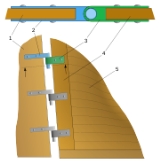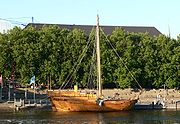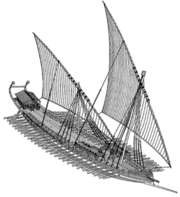
Medieval ships
Encyclopedia

Carvel (boat building)
In boat building, carvel built or carvel planking is a method of constructing wooden boats and tall ships by fixing planks to a frame so that the planks butt up against each other, edge to edge, gaining support from the frame and forming a smooth hull...
in the south. By the end of the period, carvel construction would come to dominate the building of large ships. The period would also see a shift from the steering oar
Steering oar
The steering oar or steering board is an oversized oar or board to control the direction of a ship or other watercraft prior to the invention of the rudder....
or side rudder to the stern rudder
Rudder
A rudder is a device used to steer a ship, boat, submarine, hovercraft, aircraft or other conveyance that moves through a medium . On an aircraft the rudder is used primarily to counter adverse yaw and p-factor and is not the primary control used to turn the airplane...
and the development from single to multi-masted ships.
Knarr

The knarr, a relative of the longship, was a type of cargo vessel. It differed from the longship in that it was larger and relied almost entirely on its square rigged sail for propulsion.
Cog

Cogs were single-masted vessels, clinker-built with steep sides and a flat bottom
Although the name cog is recorded as early as the 9th century , the sea going vessel of that name seems to have evolved on the Frisian coast during the 12th century. Cogs progressively replaced Viking-type ships in Northern waters during the 13th century. Why this was the case is uncertain but cogs could carry more cargo than a knarrs of a similar size. Their flat bottoms allowed them to settle flat in harbour, making them easier to load and unload. Their high sides made them more difficult to board in a seafight, which may have made them safer from pirates.
Cogs were also used as military transports and warships, fitted with towers fore and aft.
The cog traditionally reached the Mediterranean in 1304. This led to a Mediterranean variant, the cocha.
Hulk
The hulk (OE:hulc) is first recorded in the 10th century, when it is distinguished from a keel (OEceol), a ship in keeled longship tradition such as the knarr. Although clinker-built, the distinguishing feature of hulks were that they had no stem or stern posts or deep keel, being flat bottomed like a cog. Early images of hulks show them strongly curved upwards at stem and stern.Hulks continued to be mentioned in use throughout the Middle Ages and into the 16th century, when it is particularly associated with the Baltic and the Hanseatic League
Hanseatic League
The Hanseatic League was an economic alliance of trading cities and their merchant guilds that dominated trade along the coast of Northern Europe...
. These late hulks could be as large as contemporary great ships. The Jesus of Lübeck of 1544 was a ship of 700 tons, the same as the Mary Rose
Mary Rose
The Mary Rose was a carrack-type warship of the English Tudor navy of King Henry VIII. After serving for 33 years in several wars against France, Scotland, and Brittany and after being substantially rebuilt in 1536, she saw her last action on 1545. While leading the attack on the galleys of a...
. However, how similar later medieval hulks were to their ancestors is unknown. There is some evidence of a hybridisation with the cog form, showing both hulk and post construction. Others have suggested that late hulks were partially carvel-built.
Caravel

The caravel
Caravel
A caravel is a small, highly maneuverable sailing ship developed in the 15th century by the Portuguese to explore along the West African coast and into the Atlantic Ocean. The lateen sails gave her speed and the capacity for sailing to windward...
was a ship developed by the Portuguese
Portuguese people
The Portuguese are a nation and ethnic group native to the country of Portugal, in the west of the Iberian peninsula of south-west Europe. Their language is Portuguese, and Roman Catholicism is the predominant religion....
and used from the 15th century on for oceanic exploration voyages. Unlike the longship
Longship
Longships were sea vessels made and used by the Vikings from the Nordic countries for trade, commerce, exploration, and warfare during the Viking Age. The longship’s design evolved over many years, beginning in the Stone Age with the invention of the umiak and continuing up to the 9th century with...
and cog
Cog (ship)
A cog is a type of ship that first appeared in the 10th century, and was widely used from around the 12th century on. Cogs were generally built of oak, which was an abundant timber in the Baltic region of Prussia. This vessel was fitted with a single mast and a square-rigged single sail...
, it used a carvel
Carvel (boat building)
In boat building, carvel built or carvel planking is a method of constructing wooden boats and tall ships by fixing planks to a frame so that the planks butt up against each other, edge to edge, gaining support from the frame and forming a smooth hull...
method of construction. It could be either square rigged and lateen rigged (Caravela Redonda) or only lateen rigged (Caravela Latina). The most famous examples of caravels were the Niña
Niña
La Niña was one of the three ships used by Christopher Columbus in his first voyage towards the Indies in 1492. The real name of the Niña was Santa Clara. The name Niña was probably a pun on the name of her owner, Juan Niño of Moguer...
and the Pinta.
Carrack
The carrackCarrack
A carrack or nau was a three- or four-masted sailing ship developed in 15th century Western Europe for use in the Atlantic Ocean. It had a high rounded stern with large aftcastle, forecastle and bowsprit at the stem. It was first used by the Portuguese , and later by the Spanish, to explore and...
was a ship type invented in southern Europe in the 15th century and particularly developed in Portugal in the same century. It was a larger vessel than the caravel. Columbus’s ship, the Santa María
Santa María (ship)
La Santa María de la Inmaculada Concepción , was the largest of the three ships used by Christopher Columbus in his first voyage. Her master and owner was Juan de la Cosa.-History:...
was a famous example of a carrack. The ships commanded by Vasco da Gama as the São Gabriel
São Gabriel (ship)
The São Gabriel was the flagship of Vasco da Gama's armada on his first voyage to India in 1497-1499.-São Gabriel:The São Gabriel was a Portuguese "nau" that, like its sister ship, the São Rafael, was built specifically for the expedition; both exhibited similar construction...
, with six sails, a bowsprit, foresail, mizzen, spritsail and two topsails, already had the complete features and the design of the typical carrack.
Small Vessels
A number of smaller vessels are named in English sources of the Later Middle Ages, some of which continued into the 16th century and beyond.Hoy
The hoy originated in Flanders in the 15th. century. A single-masted vessel usually of 25-80 tons used a coaster or on short sea routes, as well as a lighter
Lighter (barge)
A lighter is a type of flat-bottomed barge used to transfer goods and passengers to and from moored ships. Lighters were traditionally unpowered and were moved and steered using long oars called "sweeps," with their motive power provided by water currents...
. The type would evolve in the 16th and 17th, only finally disappearing in the early 19th century.
Picard
First recorded in the 1320s, the picard was a single-masted vessel of 10-40 tons used mainly as support vessel for fishing fleets, bringing home their catches and ferrying supplies, or as a lighter, loading from vessels at anchor and discharging onto beaches or shallow creeks. A widespread type, in use from Scotland, all round the English coast and across in Ireland.
Galley

Galleys had been in use for trade and warfare since at least the 8th century BC and remained in use throughout the Middle Ages. Rowing
Watercraft rowing
Watercraft rowing is the act of propelling a boat using the motion of oars in the water. The difference between paddling and rowing is that with rowing the oars have a mechanical connection with the boat whereas with paddling the paddles are hand-held with no mechanical connection.This article...
was the primary method of propulsion, which was well-suited for often fickle winds of the Mediterranean, where they were primarily used. The galley was also used in the waters of Northern Europe, but to a lesser extent since its low freeboard
Freeboard
Freeboard may refer to:* Freeboard , the height of a ship's deck above the water level.* Freeboard , a six-wheeled skateboard designed to act like a snowboard....
and lack of stability in rough seas made it vulnerable.
Longship
The longshipLongship
Longships were sea vessels made and used by the Vikings from the Nordic countries for trade, commerce, exploration, and warfare during the Viking Age. The longship’s design evolved over many years, beginning in the Stone Age with the invention of the umiak and continuing up to the 9th century with...
was a type of ship that was developed over a period of centuries and perfected by its most famous user, the Vikings, in approximately the 9th century. The ships were clinker-built, utilizing overlapping wooden strakes.
Birlinn
In the waters off the west of Scotland between 1263 and 1500, the Lords of the IslesLord of the Isles
The designation Lord of the Isles is today a title of Scottish nobility with historical roots that go back beyond the Kingdom of Scotland. It emerged from a series of hybrid Viking/Gaelic rulers of the west coast and islands of Scotland in the Middle Ages, who wielded sea-power with fleets of...
used galleys both for warfare and for transport around their maritime domain, which included the west coast of the Scottish Highlands
Scottish Highlands
The Highlands is an historic region of Scotland. The area is sometimes referred to as the "Scottish Highlands". It was culturally distinguishable from the Lowlands from the later Middle Ages into the modern period, when Lowland Scots replaced Scottish Gaelic throughout most of the Lowlands...
, the Hebrides
Hebrides
The Hebrides comprise a widespread and diverse archipelago off the west coast of Scotland. There are two main groups: the Inner and Outer Hebrides. These islands have a long history of occupation dating back to the Mesolithic and the culture of the residents has been affected by the successive...
, and Antrim
County Antrim
County Antrim is one of six counties that form Northern Ireland, situated in the north-east of the island of Ireland. Adjoined to the north-east shore of Lough Neagh, the county covers an area of 2,844 km², with a population of approximately 616,000...
in Ireland
Ireland
Ireland is an island to the northwest of continental Europe. It is the third-largest island in Europe and the twentieth-largest island on Earth...
. They employed these ships for sea-battles and for attacking castles or forts built close to the sea. As a feudal superior, the Lord of the Isles required the service of a specified number and size of galleys from each holding of land. For examples the Isle of Man
Isle of Man
The Isle of Man , otherwise known simply as Mann , is a self-governing British Crown Dependency, located in the Irish Sea between the islands of Great Britain and Ireland, within the British Isles. The head of state is Queen Elizabeth II, who holds the title of Lord of Mann. The Lord of Mann is...
had to provide six galleys of 26 oars, and Sleat
Sleat
Sleat is a peninsula on the island of Skye in the Highland council area of Scotland, known as "the garden of Skye". It is the home of the clan MacDonald of Sleat...
in Skye had to provide one 18-oar galley.
Carvings of galleys on tombstones from 1350 onwards show the construction of these boats. From the 14th century they abandoned a steering-oar in favour of a stern rudder, with a straight stern to suit. From a document of 1624, a galley proper would have 18 to 24 oars, a birlinn
Birlinn
The birlinn was a type of boat used especially in the Hebrides and West Highlands of Scotland in the Middle Ages. The Birlinn is a Norse-Gaelic variant on the Norse longship. Variants of the name in English and Lowland Scots include "berlin" and "birling". It probably derives ultimately from the...
12 to 18 oars and a lymphad
Lymphad
thumb|200pxA Lymphad or galley is a charge used primarily in Scottish heraldry. It is a single masted ship propelled by oars. In addition to the mast and oars, the Lymphad has three flags and a basket. The word comes from the Scottish Gaelic long fhada, meaning a long ship or birlinn...
fewer still.
See also
- Horse transports in the Middle AgesHorse transports in the Middle AgesHorse transports in the Middle Ages were boats used for effective means of transporting horses over long distances, whether for war or general transport...
- Medieval European maritime cultureMedieval European maritime cultureThe medieval maritime culture began with the remnants of the naval tradition of the Roman Empire, included the technological advances that enabled the Vikings to colonize North America in 982, suffered tremendously during the crises of the 14th century, prospered to serve the European demand for...
- Byzantine navyByzantine navyThe Byzantine navy was the naval force of the East Roman or Byzantine Empire. Like the empire it served, it was a direct continuation from its imperial Roman predecessor, but played a far greater role in the defense and survival of the state then its earlier iterations...
Further reading
- Flatman, Joe (2009). Ships and Shipping in Medieval Manuscripts. British Library Publishing, ISBN 978-0-7123-4960-4
- Hutchinson, Gillian (1994). Medieval Ships and Shipping. London: Leicester University Press, ISBN 978-0-7185-0117-4
- Gardiner, R & Unger, Richard W. (1994). Cogs, Caravels, and Galleons. Conway Maritime Press, ISBN 1-55750-124-6

